[1]
He zi-shu, et al. MIMO radar and its technical characteristic analysis, ACTA electronic Sinica. vol. 33, No. 12A, (2005), p.2441.
Google Scholar
[2]
C. J. Foschini, Layered space-time architecture for wireless communication in a fading environment when using multiple antennas, Bell labs Technical Journal, Vol. 1, ( 1996) p.41.
DOI: 10.1002/bltj.2015
Google Scholar
[3]
G. J. Foschini and M. J. Gans, On the limits of wireless communications in a fading environment when using multiple antennas, Wireless Press Communication, Vol. 6, (1998), p.311.
Google Scholar
[4]
D. J. Rabideau. P Parker. Ubiquitous MIMO digital array radar. the 37th Asilomar Conference on Signals, Systems and Computers., (2003). p.1057.
DOI: 10.1109/acssc.2003.1292087
Google Scholar
[5]
E. Fishler, A. Haimowich, R. Blum, L. Cimini, D. Chizhik, and R. Valenzuela, Statistical MIMO radar. 12th Conf on Adaptive Sensor Array Processing, (2004).
Google Scholar
[6]
D. J. Rabideatu, L.C. Howard, Mitigation of digital array nonlinearities. Proc. IEEE Radar Conf., (2001), p.175.
Google Scholar
[7]
Teneketzis, D. The decentralized quickest detection problem. IEEE International Large-Scale Systems Symposium, (1982).
Google Scholar
[8]
Kovattana, T. Theoretical analysis of intrusion alarm using two complementary sensors. Final Technical Report, Stanford Research Institute, MenloPark.
Google Scholar
[9]
Fefjar, A. Combining techniques to improve security in automated entry control. Proceedings of the Carnahan Conference on Crime Countermeasures. (1978).
Google Scholar
[10]
Stearns, S.D. Optimal detection using multiple sensors. Proceedings of the Carnahan Conference on CrimeCountermeasures. ( 1982).
Google Scholar
[11]
Chair, Z. Ph.D. dissertation in progress, Syracuse University, N. Y.
Google Scholar


